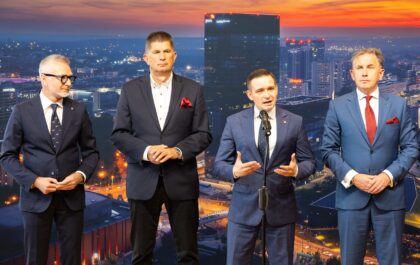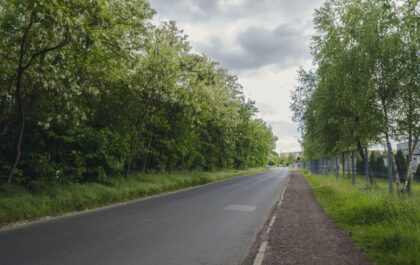
GZM FUNCTIONAL AND SPATIAL STRUCTURE
Górnośląsko-Zagłębiowska Metropolia (GZM) is the most urbanised and most densely-populated area in the Silesian voivodeship, making-up more than 20% of its surface area (2554 mk2)2and approximately 50% of the population of the voivodeship (2.2 million). To the north-east of GZM is Jura Krakowsko-Częstochowska, and to the south, the Beskids.
Distinguishing functional and special features of GZM:
- Polycentric structure composed of 41 municipalities of different sizes, population densities, levels of wealth, and development potentials (26 urban, 13 rural, and 2 urban-rural municipalities).
- Large forest area: approximately 40% of the area of GZM partly shaped in the 1960s-1970s, known as the Upper-Silesia Industrial Region Forest Protection Belt supplemented by reservoirs of anthropogenic origin.
- Numerous post-industrial land and structures: related to heavy industry, based on mining and smelting, intensively in operation until the end of the 1980s, many buildings of industrial heritage and valuable historical and architectural value.
These features mean that GZM has no other equivalent in Poland, but there are similarities between GZM and the Ruhr district in Germany or the Nord-Pas-de Calais region in France.
In spatial and functional terms, two areas can be distinguished in GZM:
- The GZM core: 18 municipalities , including 13 cities with powiat rights (the most populous and highest-ranked in the hierarchy of metropolitan functions performed) and 5 urban municipalities (influencing the spatial density of the area and having functions extending beyond local areas); characterised by a lack of clear internal administrative boundaries, as well as common historical conditions of development - intensive industrialisation and urbanisation lasting since the 19th century.
- The surroundings of the GZM core: 23 municipalities,including urban, rural and urban-rural municipalities, with a lower degree of urbanisation, population density and industrialisation than the GZM core, and with a large area of forests and agricultural land.
The municipalities that make up GZM today have been, and continue to be, subject to continuous socio-economic change. Since the 1990s, it has been transformed from an industrial area to a post-industrial one. Currently, it is an energy transformation. These transformations are accompanied by increasingly intense metropolisation. The priorities in this process are: strengthening the spatial, social and economic connectivity of GZM, creating attractive living conditions, developing metropolitan functions, and adapting to climate change, as well as preserving the valuable historical post-industrial heritage and its use in creating the modern dimension of GZM.
SPATIAL POLICY - AN ELEMENT OF THE STRATEGIC DOCUMENT
The shaping and conducting of the spatial policy in the metropolitan area is one of the tasks of the metropolitan association - according to the Act on spatial planning and development (art. 3, sec. 2a). The shaping of spatial order is one of the public tasks of GZM, clearly written out in the Act on the metropolitan involvement in the Silesian voivodeship (art. 12, sec. 1). These tasks are intended to create attractive living conditions and improve the quality of life. They are processes consisting of various types of activity on a diverse scale, often of an interdisciplinary nature. They are therefore implemented by specific departments of GZM.
A tool that relates directly to area at the metropolitan level is the obligatory element of the metropolitan association's development strategy - expressed in textual and graphic form as:
- arrangements and recommendations regarding spatial policy;
- a functional-spatial model (drawing). (rysunek).
This means that strategic arrangement should, as far as possible, be reflected in the spatial dimension. Such a solution was introduced in November 2020 as part of an amendment to a package of laws. Its aim was to pursue the integration of strategic and spatial planning (at each level of the administrative structure).
Thereby the previous legal regulation is not valid when talking about the requirements of development of the metropolitan planning document entitled the Framework Study of Conditions and trends of spatial management of the Górnośląsko-Zagłębiowska Metropolia, and regulations regarding spatial policy are included in the document entitled Development Strategy of the GZM 2022-2027 with an outlook to 2035. Its implementing tool will be the Metropolitan Strategic Action Programme, which contains a set of projects to be implemented by GZM. Ramowe Studium Uwarunkowań i kierunków zagospodarowania przestrzennego Górnośląsko-Zagłębiowskiej Metropolii, a zapisy dot. polityki przestrzennej ujęte są w dokumencie pn. Strategia Rozwoju GZM na lata 2022 – 2027 z perspektywą do 2035 r. Jej narzędziem wykonawczym będzie Metropolitalny Program Działań Strategicznych, zawierający zestaw projektów do realizacji przez GZM.
ACTIVITIES OF GZM WITH REGARDS TO SPACE AND LIVING CONDITIONS
The category and scale of activities regarding the shaping of the terrain and broader living conditions depend on the competency of GZM, which in comparison to the privileges of the municipality are more limited and usually don’t have an investment nature. This includes, as well as others, different types of analyses, spatial data, and, for example:
- a map of land accessibility:15-minute city (a solution allowing the analysis of the accessibility of public services and public green areas (parks) in close proximity to any chosen location, i.e. within a 15-minute walking or cycling distance or within 2 km); this tool serves to promote the idea of compact cities and reduce unnecessary commuting, especially by car (2022);
- a consolidated map of spatial development trends: 41 municipalities of GZM (a compilation of current drawings of the municipalities' spatial planning studies) with links to the source documents on the Public Information Bulletins of the member municipalities - periodically updated from 2020;
- the GreenGZM map:parks and squares in GZM presented against forest areas (parks additionally illustrated with a set of images and a short description about interesting facts and points of interest – updated from 2020;
- a demographic map: showing the detailed distribution of the population in 2019, with information on recorded changes since 2014. (population increase or decrease), compiled using data from the PESEL register (2019);
- the concept of metropolitan road links in the GZM area:allocating 10 main metropolitan road links to be implemented as a matter of priority, amid the system of existing and planned/designed roads of key importance for road transport in the GZM, to ensure effective internal and external links for GZM (2019).
Other examples of tasks related to the transformation of space and, more broadly, the improvement of living conditions are:
- work on a complex, long-term project and investment, such as the construction of the Metropolitan Railway Network;
- the implementation of sustainable urban mobility (not only as the development and promotion of public transport, but also as the provision of public spaces for pedestrians, minimising private transport, etc.);
- the development of cycle paths (taking into account their continuity, including the construction of Velostradas);
- the promotion of the recreational, health, and aesthetic role of public green spaces and highlighting the role of blue-green infrastructure in the adaptation of cities to climate challenges (e.g. the promotion of so-called metropolitan flower meadows).
GZM was also selected as the subject of multifaceted research of a spatial and socio-economic nature as part of the GOSPOSTRATEG project (carried out by the Institute of Urban and Regional Development 2020-2021). The aim of this research was to develop model solutions for regional development and integrating supra-local activities to strengthen the role of spatial planning in managing and shaping urbanisation processes in Poland. The direct results of the project for the GZM are metropolitan notebooks - analytical material and useful material, as well as others, for work on the GZM Development Strategy, and other routine work.
More information on spatial policy is available on the infogzm.metropoliagzm.pl website. infogzm.metropoliagzm.pl.








